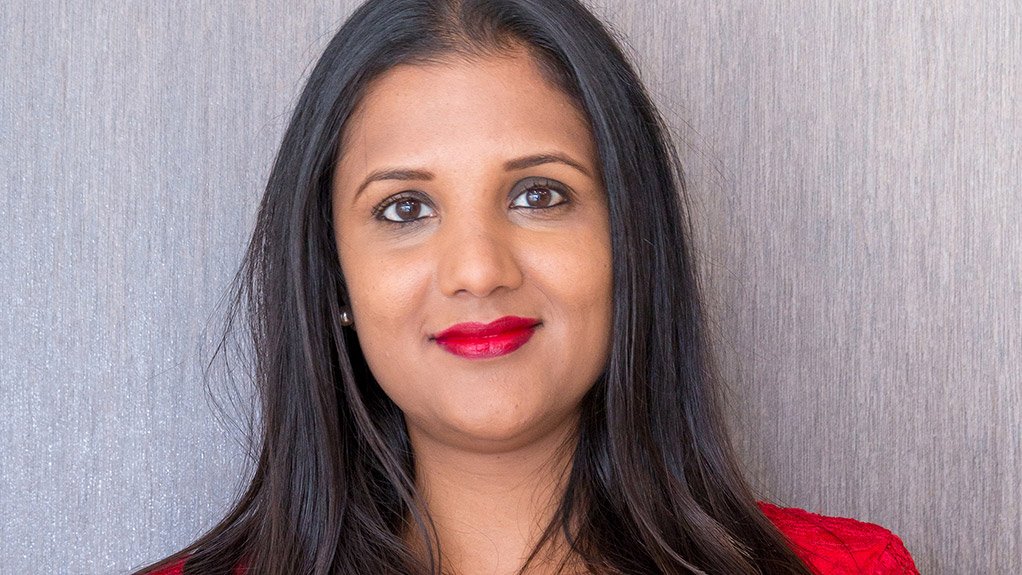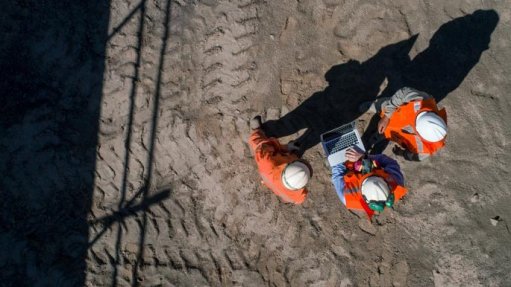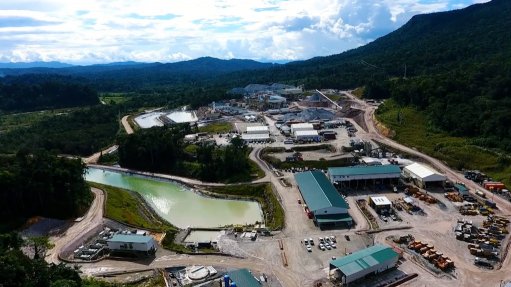Strong outlook for recovering ferrochrome industry – Merafe
Ferrochrome and chrome ore prices recovered from rock bottom in the first quarter of last year to levels twice and four times higher in 2017, a year in which a shortage of electricity supply has ceased to be a constraining factor, ferrochrome company Merafe reports.
Despite market volatility in the 12 months to December 31, coupled with the challenges and cost pressures faced by the South African ferrochrome industry, the company, headed by CEO Zanele Matlala, reported the second highest headline earnings in its history – and goes into the new year with a strong demand outlook.
Matlala said in response to Mining Weekly Online that higher ferrochrome and chrome ore prices are expected to continue for the first quarter of 2017, which she described as being indicative of a market still in deficit.
Ferrochrome-using stainless steel production is projected to grow by 3.5% in 2017 and by 3.8% in 2018, which should be followed by increased ferrochrome demand.
Merafe’s final dividend of R100.4-million brings the total dividend for 2016 to a record R120.4-million, a year-on-year increase of 83%.
“This is our highest ferrochrome revenue ever and this is also the highest chrome ore revenue ever,” Merafe financial director Kajal Bissessor told a conference call in which Creamer Media’s Mining Weekly Online participated.
The JSE-listed Merafe Resources shares in 20.5% of the Glencore-Merafe Chrome Venture’s earnings before interest, taxation, depreciation and amortisation (EBITDA), which increased by 38% from the prior year to R1 176-million in the 12 months to December 31.
Merafe’s revenue rose 29% and its headline earnings per share soared 53% to the highest level in the last five years.
On electricity supply ceasing to be a constraint, Merafe Chrome GM Dr Jurg Zaayman said in response to Standard Bank metals and mining research head Tim Clark that talks with State electricity utility Eskom are focused on opportunities to consume more electricity.
“One needs to strike a fine balance to see what can be done. But all in all, we’re very grateful that there is adequate electricity available,” Zaayman said.
The energy regulator has approved a 2.2% tariff electricity tariff increase from April 1, which is significantly lower than the
increases of the two preceding years.
The Glencore-Merafe Chrome Venture, which remains the lowest cost producer in South Africa and the second lowest cost producer globally, had a successful year both operationally and financially, achieving record ferrochrome production and laudable below-inflation cost containment.
After more than a decade of ongoing investment in a suite of projects, the Glencore-linked Merafe is in harvest mode.
The projects have included the low-energy Lion smelter complex, the Bokamoso and Tswelopele pelletising and sintering plants, upper group two (UG2) plants and the Wonderkop acquisition.
Merafe – in which the State-owned Industrial Development Corporation is a major shareholder – put its diversification plans on hold in the short to medium term.
The Lion ferrochrome smelter, owned and operated by the Glencore Merafe Chrome Venture, uses 37% less electricity and considerably less coke than conventional ferrochrome processes to produce the equivalent volume of ferrochrome.
In addition, the smelter needs far less coke than conventional smelters and uses significant amounts of locally produced, lower-cost anthracite and char.
Had the Lion operation not installed the Premus technology, it would have needed an additional 1 776 MWh to produce the same volume of ferrochrome.
Instead, all four furnaces collectively use some 4 800 MWh a day, Mining Weekly Online learnt during a visit to the smelter.
The efficient use of energy is the key source of the competitive advantage that places both phases of Lion – known as Lion I and Lion II – in a cost-leadership position.
Efficiency is enhanced through pelletising to cope with increasing volumes of fine chrome ore, in-house training programmes to overcome skills shortages and the proximity of the Port of Maputo, the use of more cost-effective upper group two (UG2) chromite ore recovered from platinum tailings, as well as radically reduced use of expensive coke.
The UG2 ore is sourced from the nearby Mototolo mine, a platinum joint venture between the London-, Hong Kong- and Johannesburg-listed Glencore, black economic-empowerment partner Kagiso Tiso and Anglo American Platinum.
The bulk of the smelter’s ore arrives by road from the Glencore-Merafe Chrome Venture’s Thorncliffe, Helena and Magareng mines, which are some 25 km away, and the final ferrochrome product leaves by road in an area not served by rail.
The pelletised material is put through prereduction kilns, which radically reduce furnace time and, thus, electricity consumption.
Lion II has doubled the 360 000 t capacity of Lion I to give the Lion smelter a combined capacity of 720 000 t/y of ferrochrome. Lion II was built at a capital cost of R4.9-billion and includes the Magareng mine.
The Glencore Merafe Chrome Venture owns a number of chromite mines and, 22 ferrochrome furnaces, with a combined installed capacity of 2.34-million tons of ferrochrome a year.
Thirteen of these furnaces, situated at Rustenburg, Wonderkop and Lydenburg, use a combination of conventional semiclosed submerged arc furnace and Outokumpu pelletiser technology.
The 396 000 t/y Lydenburg operation pioneered the Premus process ahead of its adoption at the Lion project. The Boshoek operation comprises two closed furnaces based on fully fledged Outokumpu pelletising technology including preheating.
Merafe reported a 61% year-on-year increase in chrome ore revenue on 38% higher chrome ore sales volumes to 372 000 t and 7% higher chrome ore prices.
In the first quarter, ferrochrome and chrome ore prices hit rock bottom but started recovering from the second quarter.
By the end of the year, ferrochrome prices had more than doubled and UG2 prices more than quadrupled.
The rand/dollar exchange rate fluctuated significantly and the closing rate at the end of 2015 was R15.50 whereas at the end of 2016 it was R13.70.
However, on average it weakened 15% for the year.
The Chinese economy, on which the ferrochrome and chrome ore markets are heavily dependent, grew by 6.7% year-on-year, underpinning pleasing growth in stainless steel production.
The company reported cash from operating activities at a healthy R501-million, which prompted the declaration of and a final dividend of R100-million.
Lion II operated fully for the whole year and refurbishments were done early in the year when demand was slower and this
allowed for increased production in the winter months as demand was picking up.
On the labour front, the western mines’ three-year wage agreement of 2014 is up for renegotiation in the second half of this year, with the smelters agreement
expiring in 2018.
Production costs were managed well below inflation, despite above-inflation electricity and labour costs, higher UG2 input costs and the impact of the weaker rand on imported items.
The main reason for the good cost performance were low-cost volumes from Lion II, overall higher production volumes and various cost-saving initiatives across the operation.
Global stainless steel production rose 8.8%, well above the projected 2.8%.
China, which produced 54% of global stainless steel, showed the biggest growth of 13.3%, followed by the US at 6.7%, India at 6.6% and Europe at 1.8%, driven by strong performance in electronics, automotive, machinery and equipment.
Global ferrochrome demand followed a similar trend and increased by 7.6% year-on-year.
China showed the highest growth of 9.4%, accompanied by growth from the European Union, the Americas and Japan.
First quarter ferrochrome prices reached historical lows at 54 USc/lb, but signs of recovery emerged in the second quarter and by the end of 2016, prices had more than doubled to 135 USc/lb, driven by a surge in Chinese stainless steel production.
Global ferrochrome production increased by 4.9%, China increasing by 11.8% and Kazakhstan by 19.2% owing to mainly new capacity.
South Africa, on the other hand, registered a ferrochrome production decline of 3.2% owing to the exit of three producers in 2015.
Chrome ore imports into China rose 1.7% to 10.6-million tonnes, with South Africa
accounting for 73.3% of these imports, an increase of 2.2%.
Iran grew by 7.2% and Albania by 1.6%, with Oman declining by 23%. Chrome ore stocks at the Chinese ports were estimated to be 1.5-million tonnes at the end of 2016.
Like ferrochrome, chrome ore prices hit rock bottom in the first quarter with UG2 prices dropping to $80/t.
However, by December UG2 prices had recovered remarkably to around $400/t, a 400% increase, driven by increased demand from mainly China and supply constraints, Matlala told mining analysts and journalists in the conference call in which Bissessor described the results as being “nothing short of exceptional”.
Total revenue increased by 29% to R5.7-billion, EBITDA was up by 39% to R1.1-billion. Headline earnings per share was up by 53% to 21.2 c a share. Net debt reduced by 38% year-on-year to R409-million.
Ferrochrome sales volumes were up 18% to a record 437 000 t, which Bissessor put down to “the huge effort by the marketing team in a tough market”.
Whereas the net ferrochrome prices were down 7%, the price recovered significantly in the last quarter, with realised December prices 88% higher than the year’s lows.
Ferrochrome revenue at R4 923-million and chrome ore sales at 372 000 t were the highest ever.
Merafe’s 20,5% of venture EBITDA of R1.2-billion yielded a profit of R532-million after corporate costs, share-based payments, depreciation, financing and tax.
Ninety per cent of the after-tax profit was earned in the second half of 2016, hoisted by 33% higher ferrochrome prices and a doubling of chrome ore revenue on 60% higher volumes and 69% higher prices.
Merafe began the year with net cash of R310-million, generated R501-milllion from operating activities, invested R276-million in sustaining capital expenditure, paid dividends of R50-million, repaid debts of R197-million and closed with cash of R263-million.
The cash generated from operating activities was significantly down on 2015 owing to a lot of the 2016 revenue being earned in the last quarter. With 90- to 120-days payment terms, cash will largely be collected in the first quarter of 2017.
Cash at Merafe level was R209-million and Merafe’s share of the cash balance in the venture was R54-million.
Total net debt at Merafe level was R409-million, which reduced by R251-million year-on-year.
The company, which is left with significant headroom of R774-million, remains committed to reducing debt and increasing dividends.
Going forward, a minimum of 30% of headline earnings will be declared as dividends.
In addition, special dividends will bendeclared if there is surplus cash not required by the business.
Comments
Press Office
Announcements
What's On
Subscribe to improve your user experience...
Option 1 (equivalent of R125 a month):
Receive a weekly copy of Creamer Media's Engineering News & Mining Weekly magazine
(print copy for those in South Africa and e-magazine for those outside of South Africa)
Receive daily email newsletters
Access to full search results
Access archive of magazine back copies
Access to Projects in Progress
Access to ONE Research Report of your choice in PDF format
Option 2 (equivalent of R375 a month):
All benefits from Option 1
PLUS
Access to Creamer Media's Research Channel Africa for ALL Research Reports, in PDF format, on various industrial and mining sectors
including Electricity; Water; Energy Transition; Hydrogen; Roads, Rail and Ports; Coal; Gold; Platinum; Battery Metals; etc.
Already a subscriber?
Forgotten your password?
Receive weekly copy of Creamer Media's Engineering News & Mining Weekly magazine (print copy for those in South Africa and e-magazine for those outside of South Africa)
➕
Recieve daily email newsletters
➕
Access to full search results
➕
Access archive of magazine back copies
➕
Access to Projects in Progress
➕
Access to ONE Research Report of your choice in PDF format
RESEARCH CHANNEL AFRICA
R4500 (equivalent of R375 a month)
SUBSCRIBEAll benefits from Option 1
➕
Access to Creamer Media's Research Channel Africa for ALL Research Reports on various industrial and mining sectors, in PDF format, including on:
Electricity
➕
Water
➕
Energy Transition
➕
Hydrogen
➕
Roads, Rail and Ports
➕
Coal
➕
Gold
➕
Platinum
➕
Battery Metals
➕
etc.
Receive all benefits from Option 1 or Option 2 delivered to numerous people at your company
➕
Multiple User names and Passwords for simultaneous log-ins
➕
Intranet integration access to all in your organisation






















